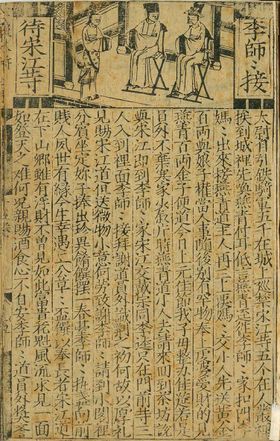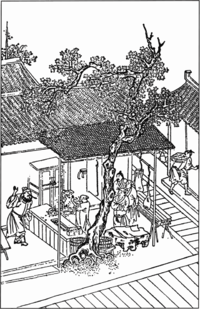حافة الماء
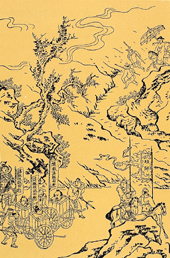 رسم توضيحي من الرواية | |
| المؤلف | شي نايآن |
|---|---|
| العنوان الأصلي | 水滸傳 |
| البلد | الصين |
| اللغة | الصينية |
| الصنف | رواية تاريخية |
| حافة الماء | |||||||||||||||||||||||||||||
|---|---|---|---|---|---|---|---|---|---|---|---|---|---|---|---|---|---|---|---|---|---|---|---|---|---|---|---|---|---|
 "حافة الماء" بحروف صينية تقليدية (أعلى) ومبسطة (أسفل) | |||||||||||||||||||||||||||||
| الصينية التقليدية | 水滸傳 | ||||||||||||||||||||||||||||
| الحروف المبسطة | 水浒传 | ||||||||||||||||||||||||||||
| المعنى الحرفي | "Water Margin Story" | ||||||||||||||||||||||||||||
| |||||||||||||||||||||||||||||
حافة الماء (Shui Hu Zhuan، وأحياناً تُختصر إلى Shui Hu)، كما تُترجم إلى خوارج المستنقعات، حكاية المستنقعات، كل الرجال أخوة، رجال المستنقعات، أو مستنقعات جبل ليانگ، هي رواية منسوبة إلى شي نايآن. وتـُعد واحدة من الروايات الكلاسيكية الأربع العظام في الأدب الصيني، وهي مكتوبة بالصينية العامية بدلاً من الصينية الكلاسيكية.[1]
تتناول رواية «أبطال على شاطئ البحيرة» حياة مئة وثمانية أبطال شعبيين هبوا لدفع الظلم ودحر العدوان ومساعدة المحتاجين، أخذوا من الأغنياء لمساعدة الفقراء، وشنوا حملات ضد الطغاة والمستعمرين. تحدث أفراد الشعب عن بطولة هؤلاء بالطريقة التي يحبذون، ورسموا لهم الصورة التي يحلمون، وأضافوا لهم القيم التي يرغبون. نالت هذه الرواية ثناء فنياً على مدى التاريخ؛ إذ صنفها جين شنگ تان Jin Sheng Tan في المرتبة الخامسة بين أمهات الكتب الصينية ووجد فيها رواية تشمل وصفاً لمئة وثماني شخصيات، لكل منها مضمونها ومظهرها ولغتها. ومن أهم خصائص الرواية الفنية رسمها الشخصيات الرئيسة وتطورها على نحو فريد وواضح، كما أن لغة الرواية مختارة وغنية، مؤثرة، بليغة، بسيطة، حية، معبرة، ضيقت الهوة بين لغة الأدب ولغة العامة.
السياق والتطور التاريخي
Water Margin was based on the exploits of the outlaw Song Jiang and his 36 companions. The group was active in the Huainan region and surrendered to the Song government in 1121. They were recorded in the historical text History of Song. The name of "Song Jiang" also appeared in the biography of Emperor Huizong of Song, which stated:
The outlaw Song Jiang of Huainan and others attacked the army at Huaiyang, (the Emperor) sent generals to attack and arrest them. (The outlaws) infringed on east of the capital (Kaifeng), Hebei, and entered the boundaries of Chu (referring to present-day Hubei and Hunan) and Haizhou (covering parts of present-day Jiangsu). The prefect Zhang Shuye was ordered to pacify them.[2]
يحكى أن شي نايآن اشترك في انتفاضة الفلاحين التي قادها ژانگ شي چنگ Zhang Shi Cheng ت(1321ـ1367) ورأى بأم عينه مظالم المجتمع وجور الحكام وفساد السياسة. كتب رواية «حافة الماء»، كما شارك بكتابة «عاطفيات الممالك الثلاث» (إحدى الروايات الكلاسيكية العظيمة الأربع) و«تاريخ سوي وتانگ» مع تلميذه الكاتب لوو گوانژونگ Guan Zhong Luo. وتذكر بعض المراجع أن ناي آن شي كتب الرواية وشارك لوو في العمل؛ ويرد في مراجع أخرى أنه هو الذي ألفها وأعاد لوو كتابتها؛ وتذكر مراجع أخرى أن ناي آن شي كتب نصفها وأكملها لوو. وهناك آراء تقول إن آخر كاتب أعاد كتابة الرواية في صياغتها النهائية هو ناي آن شي.
الحبكة
المشهد الافتتاحي في الرواية هو اطلاق 108 روحاً، كانت حبيسة تحت تمثال عتيق لسلحفاة تحمل نصباً.[3]
ملخص فصول الرواية
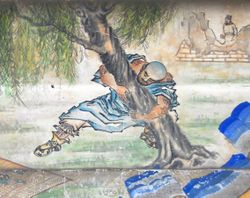
The following outline of chapters is based on a 100 chapters edition. Yang Dingjian's 120 chapters edition includes other campaigns of the outlaws on behalf of Song dynasty, while Jin Shengtan's 70 chapters edition omits the chapters on the outlaws' acceptance of amnesty and subsequent campaigns.
| الفصل | الأحداث الرئيسية |
|---|---|
| 1 | Marshal Hong releases the 108 spirits |
| 2 | The rise of Gao Qiu |
| 2–3 | The story of Shi Jin |
| 3–7 | The story of Lu Zhishen |
| 7–12 | The story of Lin Chong |
| 12–13 | The story of Yang Zhi |
| 13–20 | The robbing of the birthday gifts by the "Original Seven" |
| 20–22 | The story of Song Jiang |
| 23–32 | The story of Wu Song |
| 32–35 | The story of Hua Rong |
| 36–43 | Song Jiang's encounters in Jiangzhou |
| 44–47 | The story of Shi Xiu and Yang Xiong |
| 47–50 | The three assaults on the Zhu Family Village |
| 51–52 | The story of Lei Heng and Zhu Tong |
| 53–55 | The outlaws attack Gaotangzhou; the search for Gongsun Sheng |
| 55–57 | The first imperial assault on Liangshan Marsh (led by Huyan Zhuo) |
| 57–59 | The outlaws attack Qingzhou; Huyan Zhuo defects to Liangshan |
| 59–60 | The outlaws led by Gongsun Sheng attack Mount Mangdang |
| 60 | The first assault by the outlaws on the Zeng Family Village; the death of Chao Gai |
| 60–67 | The story of Lu Junyi; the outlaws attack Daming Prefecture; the second imperial assault on Liangshan Marsh (led by Guan Sheng) |
| 67 | Guan Sheng defects to Liangshan; The third imperial assault on Liangshan Marsh (led by Shan Tinggui and Wei Dingguo) |
| 68 | The second assault by the outlaws on the Zeng Family Fortress; |
| 69–70 | The outlaws attack Dongping and Dongchang prefectures |
| 71–74 | The Grand Assembly; the funny and lethal antics of Li Kui |
| 75–78 | Emperor Huizong offers amnesty for the first time; the fourth imperial assault on Liangshan Marsh (led by Tong Guan) |
| 78–80 | The fifth imperial assault on Liangshan Marsh (led by Gao Qiu) |
| 81–82 | The outlaws are granted amnesty |
| 83–89 | The Liangshan heroes attack the Liao invaders |
| 90–99 | The Liangshan heroes attack Fang La |
| 100 | The tragic dissolution of the Liangshan heroes |
مؤلفها
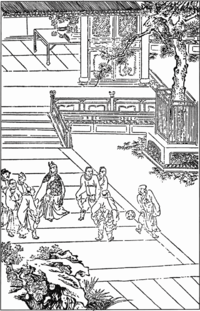
There is still uncertainty on the authorship of Water Margin, which in any case derived from many sources and many hands. While most attribute the novel to Shi Nai'an,[4] some believe that the novel, or portions of it, was written or revised by others, such as لوو گوانژونگ (مؤلف غراميات الممالك الثلاث),[5] Shi Hui (施惠) and Guo Xun (郭勛).
الترجمات
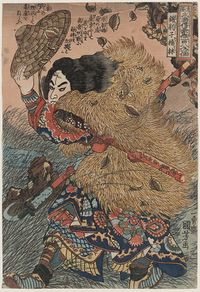
أثرها
تُعد «طرف الماء أو أبطال على شاطئ البحيرة» من الروايات التي يحبذ العامة سماعها، لا بل أسهموا في تأليفها. فهي تستند إلى سير شعبية تستند بدورها إلى وقائع تاريخية حقيقية، أبدعها الشعب وصاغها كاتب مبدع رصد فيها انتفاضات الفلاحين التي اندلعت في عهد أسرة سونگ، ولاسيما الانتفاضة التي قادها سونگ جيانگ Song Jiang ما بين عامي 1119-1125 وشملت مناطق شاندونگ Shan Dong، خِنان He Nan، خِبي He Bei، جيانگسو Jiang Su.
الهامش
- ^ Yenna Wu, "Full-Length Vernacular Fiction," in Victor Mair, (ed.), The Columbia History of Chinese Literature (NY: Columbia University Press, 2001), pp. 627-629.
- ^ Toktoghan et al. History of Song, Volume 22, Biography of Emperor Huizong (Part Four).
- ^ Wang, Jing (1992), The story of stone: intertextuality, ancient Chinese stone lore, and the stone symbolism in Dream of the red chamber, Water margin, and The journey to the west, Duke University Press, pp. 252–254, ISBN 0-8223-1195-X, http://books.google.com.au/books?id=49brOdOKlD0C, which includes the English translation of the relevant excerpt from the novel. The original text of the chapter can be seen e.g. at 水滸傳/第001回, starting from "只中央一個石碑,約高五六尺,下面石龜趺坐 ..."
- ^ Henderson, Lesley and Sarah M. Hall (1995). Reference guide to world literature, Volume 2. St. James Press. p. 1310. ISBN 1-55862-333-7.
- ^ Wilt Idema and Lloyd Haft. A Guide to Chinese Literature. (Ann Arbor: Center for Chinese Studies, The University of Michigan, 1997; ISBN 0892641231), p. 203.
للاستزادة
- C. T. Hsia, "The Water Margin," in C.T. Hsia, The Classic Chinese Novel: A Critical Introduction (1968; rpr. Cornell University Press, 1996), pp. 75–114.
- 水滸伝 (Water Margin). Yoshikawa Kojiro and Shimizu Shigeru (translators). Iwanami Shoten. 1998-10-16.
{{cite book}}: CS1 maint: others (link) - Haruo Shirane and James Brandon. Early Modern Japanese Literature: An Anthology, 1600-1900. Columbia University Press (2002). ISBN 0-231-10990-3.
- John Dent-Young, "Translating Chinese Fiction: The Shui Hu Zhuan," in Sin-Wai Chan and David Pollard, An Encyclopedia of Translation: Chinese-English, English-Chinese (Hong Kong: Chinese University Press, 1995), 249-261. [1]
- Wai-Yee Li. Full-Length Vernacular Fiction. in V. Mair, (ed.), The Columbia History of Chinese Literature (NY: Columbia University Press, 2001), esp. pp. 626–332.
وصلات خارجية
- Outlaws of the Marsh: A Somewhat Less Than Critical Commentary
- (بالفرنسية) Chinese paper-cuts of the novel and its characters
- (صينية) Article about the three major editions
- (Japanese) Nicknames of the 108 heroes
- (Japanese) Stylized illustrations of the 108 heroes
- Steve Donoghue. Book Review: The Water Margin. Open Letters Monthly.
{{cite book}}: Italic or bold markup not allowed in:|publisher=(help)
